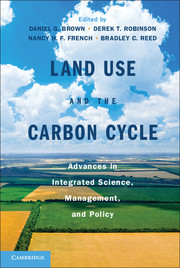Book contents
- Frontmatter
- Contents
- Chapter Authors and Affiliations
- Acknowledgments
- Acronyms
- Part I Introduction
- 1 Linking Land Use and the Carbon Cycle
- 2 An Introduction to Carbon Cycle Science
- 3 The Contribution of Land Use and Land-Use Change to the Carbon Cycle
- 4 An Economic Analysis of the Effect of Land Use on Terrestrial Carbon Storage
- Part II Measurement and Modeling
- Part III Integrated Science and Research Applications
- Part IV Land Policy, Management, and the Carbon Cycle
- Part V Synthesis and Future Directions
- Index
- Plate Section
- References
3 - The Contribution of Land Use and Land-Use Change to the Carbon Cycle
Published online by Cambridge University Press: 05 February 2013
- Frontmatter
- Contents
- Chapter Authors and Affiliations
- Acknowledgments
- Acronyms
- Part I Introduction
- 1 Linking Land Use and the Carbon Cycle
- 2 An Introduction to Carbon Cycle Science
- 3 The Contribution of Land Use and Land-Use Change to the Carbon Cycle
- 4 An Economic Analysis of the Effect of Land Use on Terrestrial Carbon Storage
- Part II Measurement and Modeling
- Part III Integrated Science and Research Applications
- Part IV Land Policy, Management, and the Carbon Cycle
- Part V Synthesis and Future Directions
- Index
- Plate Section
- References
Summary
Introduction
The global carbon (C) cycle can be characterized in multiple ways. In Chapter 2, C pools, fluxes, and mechanisms controlling the size and rates of pools and fluxes of C are reviewed as a whole. In this chapter, the primary concern is with annual net exchanges of C between the atmosphere and three other major C pools – land, oceans, and fossil fuels – with an emphasis on the role that land use and land-use change have in adding C to or removing it from the atmosphere. The net exchanges are important because they determine the rate at which carbon dioxide (CO2) accumulates in the atmosphere and, hence, the rate and extent of climate change.
The dominant feature of the annual net global emissions of C from land use and land-use change is the gradually increasing trend over the past 155 years (1850 to 2005; Figure 3.1) and probably much longer (Kaplan, Krumhardt, and Zimmermann 2009). This trend, however, is misleading for at least two reasons. First, the trend is not representative of any specific geographic region; because the trend is global, it obscures regional trends. The gradually increasing trend is the result of recently decreasing net emissions and increasing sinks in developed countries (in temperate and boreal zones) offsetting more rapidly increasing net emissions from developing countries in the tropics (Figure 3.2). Second, the net emissions hide the much larger gross sources and sinks of C from land use and land-use change (Figure 3.3). More C is emitted to and removed from the atmosphere each year as a direct result of human activity than is revealed by estimates of the net flux.
- Type
- Chapter
- Information
- Land Use and the Carbon CycleAdvances in Integrated Science, Management, and Policy, pp. 52 - 76Publisher: Cambridge University PressPrint publication year: 2013



